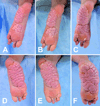Progressive overgrowth of the cerebriform connective tissue nevus in patients with Proteus syndrome
- PMID: 20709429
- PMCID: PMC3240941
- DOI: 10.1016/j.jaad.2009.12.012
Progressive overgrowth of the cerebriform connective tissue nevus in patients with Proteus syndrome
Abstract
Background: Proteus syndrome is a rare overgrowth disorder that almost always affects the skin.
Objective: Our purpose was to evaluate progression of skin lesions in patients with Proteus syndrome.
Methods: Skin findings were documented in 36 patients with Proteus syndrome. Progression of skin lesions in 16 of these patients was assessed by comparing photographs obtained on repeated visits for an average total duration of 53 months.
Results: The skin lesion most characteristic of Proteus syndrome, the cerebriform connective tissue nevus, showed progression in 13 children but not in 3 adults. The cerebriform connective tissue nevus progressed by expansion into previously uninvolved skin, increased thickness, and development of new lesions. Lipomas increased in size, number, or both in 8 of 10 children with lipomas. In contrast, epidermal nevi and vascular malformations generally did not spread or increase in number.
Limitations: Only 3 adults with Proteus syndrome were evaluated longitudinally.
Conclusion: The cerebriform connective tissue nevus in Proteus syndrome grows throughout childhood but tends to remain stable in adulthood.
Copyright © 2009 American Academy of Dermatology, Inc. Published by Mosby, Inc. All rights reserved.
Conflict of interest statement
Figures



Similar articles
-
Evolution of skin lesions in Proteus syndrome.J Am Acad Dermatol. 2005 May;52(5):834-8. doi: 10.1016/j.jaad.2004.12.047. J Am Acad Dermatol. 2005. PMID: 15858474
-
Pathogenetic insights from quantification of the cerebriform connective tissue nevus in Proteus syndrome.J Am Acad Dermatol. 2018 Apr;78(4):725-732. doi: 10.1016/j.jaad.2017.10.018. Epub 2017 Oct 16. J Am Acad Dermatol. 2018. PMID: 29042227 Free PMC article.
-
Isolated plantar collagenoma not associated with Proteus syndrome.J Am Acad Dermatol. 2008 Mar;58(3):497-9. doi: 10.1016/j.jaad.2007.03.016. J Am Acad Dermatol. 2008. PMID: 18280350
-
Proteus syndrome: three case reports with a review of the literature.Fetal Pediatr Pathol. 2012 Jun;31(3):145-53. doi: 10.3109/15513815.2012.656830. Epub 2012 Mar 13. Fetal Pediatr Pathol. 2012. PMID: 22413928 Review.
-
Epidermal Nevi and Related Syndromes -- Part 1: Keratinocytic Nevi.Actas Dermosifiliogr (Engl Ed). 2018 Oct;109(8):677-686. doi: 10.1016/j.ad.2018.05.005. Epub 2018 Jul 6. Actas Dermosifiliogr (Engl Ed). 2018. PMID: 29983155 Review. English, Spanish.
Cited by
-
Neurocutaneous Manifestations of Genetic Mosaicism.J Pediatr Genet. 2015 Sep;4(3):144-53. doi: 10.1055/s-0035-1564441. Epub 2015 Nov 30. J Pediatr Genet. 2015. PMID: 27617125 Free PMC article. Review.
-
Proteus Syndrome with Arteriovenous Malformation.Adv Biomed Res. 2017 Mar 7;6:27. doi: 10.4103/2277-9175.201684. eCollection 2017. Adv Biomed Res. 2017. PMID: 28401074 Free PMC article.
-
Late-onset Proteus syndrome with cerebriform connective tissue nevus and subsequent development of intraductal papilloma.Am J Med Genet A. 2022 Sep;188(9):2766-2771. doi: 10.1002/ajmg.a.62761. Epub 2022 Apr 20. Am J Med Genet A. 2022. PMID: 35441778 Free PMC article.
-
Proteus syndrome with sciatic nerve fibrolipomatous hamartoma: an uncommon finding in a rare disease: report of two cases with literature review.BJR Case Rep. 2021 Dec 13;8(2):20210153. doi: 10.1259/bjrcr.20210153. eCollection 2022 Mar 10. BJR Case Rep. 2021. PMID: 36177257 Free PMC article.
-
A limited form of proteus syndrome with bilateral plantar cerebriform collagenomas and varicose veins secondary to a mosaic AKT1 mutation.JAMA Dermatol. 2014 Sep;150(9):990-3. doi: 10.1001/jamadermatol.2013.10368. JAMA Dermatol. 2014. PMID: 24850616 Free PMC article.
References
-
- Cohen MM, Jr, Hayden PW. A newly recognized hamartomatous syndrome. Birth Defects Orig Artic Ser. 1979;15:291–296. - PubMed
-
- Wiedemann HR, Burgio GR, Aldenhoff P, Kunze J, Kaufmann HJ, Schirg E. The proteus syndrome. Partial gigantism of the hands and/or feet, nevi, hemihypertrophy, subcutaneous tumors, macrocephaly or other skull anomalies and possible accelerated growth and visceral affections. Eur J Pediatr. 1983;140:5–12. - PubMed
-
- Turner JT, Cohen MM, Jr, Biesecker LG. Reassessment of the Proteus syndrome literature: application of diagnostic criteria to published cases. Am J Med Genet A. 2004;130A:111–122. - PubMed
-
- Biesecker LG, Happle R, Mulliken JB, Weksberg R, Graham JM, Jr, Viljoen DL, et al. Proteus syndrome: diagnostic criteria, differential diagnosis, and patient evaluation. Am J Med Genet. 1999;84:389–395. - PubMed
-
- Twede JV, Turner JT, Biesecker LG, Darling TN. Evolution of skin lesions in Proteus syndrome. J Am Acad Dermatol. 2005;52:834–838. - PubMed
Publication types
MeSH terms
Grants and funding
LinkOut - more resources
Full Text Sources
Medical

